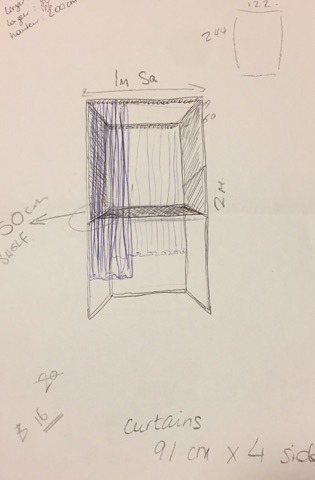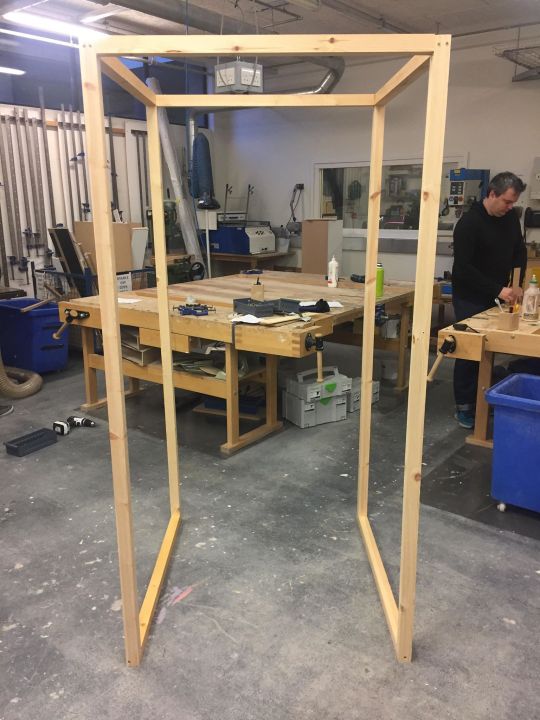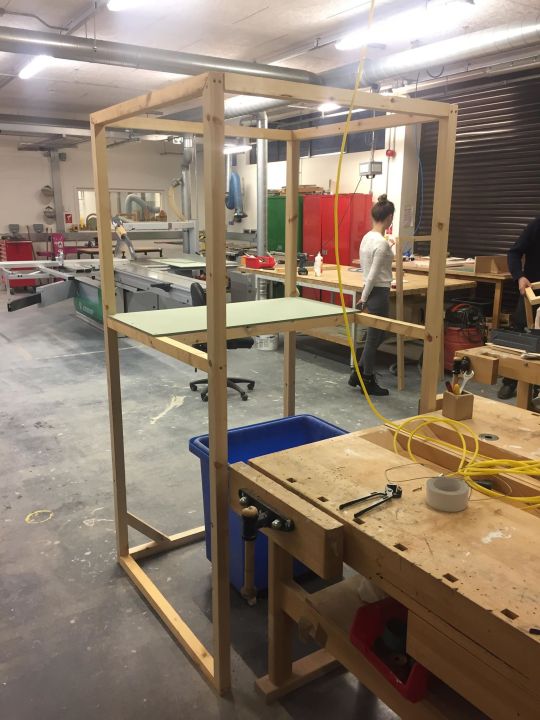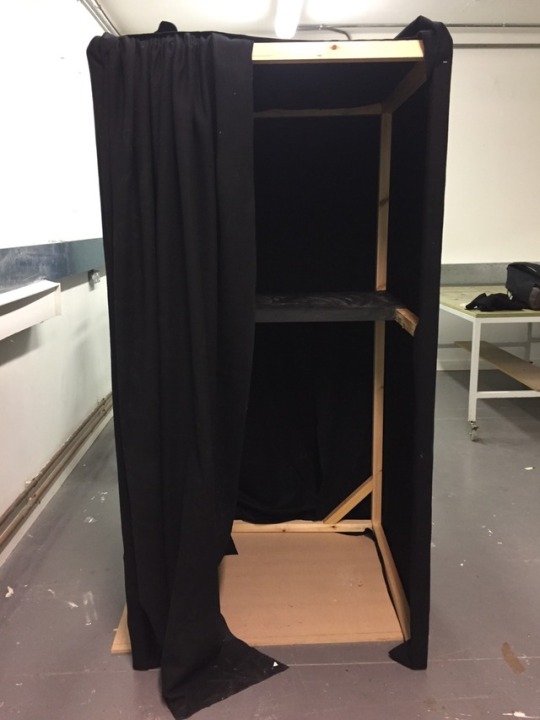Text
Conclusion
After the initial briefing presentation of the second project I decided quickly to use the voting booth as a space to work with. I was inspired by that space because at the moment I was working at the Churchill War Room Museum and that place inspired me to work around the idea of politic. I was inspired by the fact that art (the museum itself) can be linked with politic even if at first you wouldn’t think it would be a nice mix. Then I thought it was interesting to work with expanded media with the voting booth because I have never voted and never been inside one.
From there I decided to work on the notion of art and politic and then on, to experiment some editing exclusively from videos from Youtube linked with the theme of art, politic, war footage, violence… but I realised with the help of the workshops I had that I needed to be more concise in my work because with what I was aiming for that was the best option to go to. I edited many time my video.
Finally, I landed on the idea of recreating the voting booth itself and rethinking the action of voting. With the help of the people at the 3D workshop I built it in one afternoon- it was surprisingly easy, and I tried to built it as possible as a real one. I put real curtains but I didn’t liked the result, and then I came back home in France for the Christmas holiday, and I came across some newspapers of Charlie Hebdo that I still had in my possession. I thought it was a good idea to use them to built the voting booth, and it gave me the possibility to again explore new directions in the edit of my video.
In the end, my aim aim for the project was if after watching the video you feel a bit depressed about the state of the world, or if you ask yourself some question on how can we change that, that would mean I have achieved my goal.
https://vimeo.com/user92234195/review/310649372/4e800a28da
0 notes
Text
Edit
I chose to work this way and create a video from footage from youtube because I wanted to learn how to use FCP, as I have no technical skills regarding editing and this is the first time that I use this software.
Process:
First I search for the videos on Youtube that I founded relevant (although I did that through the whole time because I change ideas several times during the course of the work),and I look for the one that I knew I wanted to use from the beginning.
Then I selected inside each video the moments that I wanted to keep.
Then I mixed them together.
The “soundtrack” of the video comes from the first scene of the video (migrants in Paris). I thought the sound in that video gave a sense of tension and anxiety and it was perfect for what I wanted to give to the viewer. So I duplicated it the sound on itself several time and it was like music.
Then the last element I brought was the recording of my voice.
I understand that the way I edited this video is not groundbreaking nor innovative, but I wasn’t looking for that with this project. I was more looking to produce something that can be pertinent and catchy for citizens, or people that don’t care about artistic stuff. And it reflect one of my though about the art work, which I find sometimes (most of the time) really close minded.
Hanging out with artist and you will only talk about art, hanging out about with filmmaker and they will only talk about movies.
I think the art world should be more open on the world and some issues, because the way I think, to produce art you have to use or get inspired by what is happening outside, not only by what has been done by artist before.
Like what is the point of always seeking innovation when everything has already been done, and there is so many stuff to fix or improve around anyway.


0 notes
Text
Blasphemy
Google definition: the action or offence of speaking sacrilegiously about God or sacred things; profane talk.
Some religions consider blasphemy to be a religious crime. As of 2012, anti-blasphemy laws existed in 32 countries.
France removed the ban of blasphemy in 1881 to allow freedom of religion and freedom of the press and blasphemy was abolished or repealed in Sweden in 1970, England and Wales in 2008, Norway with Acts in 2009 and 2015, the Netherlands in 2014, Iceland in 2015, Malta in 2016 and Denmark in 2017.
Christian theology condemns blasphemy. It is spoken of in Mark 3:29, where blaspheming the Holy Spirit is spoken of as unforgivable—an eternal sin. Blasphemy has been condemned as a serious sin by the major creeds and Church theologians.
Charlie Hebdo was attacked for their cartoons considered a blasphemy.
Enrique Chagoya
youtube
Enrique Chagoya's "The Misadventures of the Romantic Cannibals," created in 2003, is a multipanel piece in which "cultural and religious icons are presented with humor and placed in contradictory, unexpected and sometimes controversial contexts.
The artist is known in the art world for his whimsical, satirical paintings, prints, and illustrated, codex-like manuscripts reflecting a world in dizzying political and cultural flux. His work has always had an unapologetically irreverent edge. But Chagoya's worldwide reputation was ignited one fall day in 2010, when a Montana woman took a crowbar to The Misadventures of the Romantic Cannibals, a multipanel lithograph depicting a sexually suggestive image of Jesus that had drawn feverish protests when it was shown at a museum in Loveland, Colo. Chagoya discusses and shows a video about the attack on that work, a commentary on the Catholic priest sex abuse cases that was dismissed by Chagoya's detractors as "sacrilegious pornography," and its unexpected aftermath.
My take:
The notion of blasphemy is only a matter of perception and believes. For the strong atheist that I am, blasphemy should be a right or at least accepted. Because it is for me a way to put religious institution (therefore institution with power) in perspective. Without the right to use blasphemy there is a loss in the freedom of expression, and the right to use satire or laugh about it would be loss too.
0 notes
Text
Minimalist music
La Monte Thornton Young american avant-garde composer, musician, and artist generally recognized as the first minimalist composer. His works are cited as prominent examples of post-war experimental and contemporary music, and were tied to New York's downtown music and Fluxus art scene. Young is perhaps best known for his pioneering work in Western drone music (originally referred to as "dream music").
Young's work has called into question the nature and definition of music. Despite having released very little recorded material throughout his career Vulture described him as the most influential living composer today. His evolving composition The Well-Tuned Piano, first conceived in 1964, has been characterized as "one of the great achievements of 20th-century music by The Guardian.
Steve Reich - It’s Gonna Rain / American composer pioneered of minimal music in the mid 60′. Using tape loops to create phasing patterns. Exploring musical concepts. Repetitive rhythms canons.
A single chord, a brief musical motif, a spoken exclamation—which are repeated at length, with small variations introduced very slowly, are the base of Reich experiments (It’s Gonna Rain/1965 and Come Out/1966).
He is one of the most influenced composer of the 21 century.
youtube
My take:
For me it relates to Martin Arnold work but instead of using video they uses music. It is gonna rain from Steve Reich for example is very similar to what Martin Arnold or Bruce Connor did, but instead of using images Steve Reich uses sound. It is very interesting to look for experiments in different medium because it helps getting a large spectrum of what can be done, what has been done.
For the edit of the video the work of Steve Reich inspired me to use the soundtrack of the first scene in the video and loop it through the entire video
0 notes
Text
Marco Evaristti
Chilean artist living in Denmark since 1980.
Known for his work that put live goldfish in a blender.
Pink State: independent state, a state of mind with passport and constitution, but without government control. Although imaginary, the artist materialise it from time to time in his transitory landscape works.
Manifestations of Pink State have included 2004's The Ice Cube Project which consisted in painting the exposed tip of a small iceberg in red. This took place on March 24, in Kangia fiord near Ilullissat, Greenland. With two icebreakers and a twenty-man crew, Evaristti used three fire hoses and 3,000 litres of paint to color the iceberg blood-red. The artist commented that, "We all have a need to decorate Mother Nature because it belongs to all of us.
The Mont Rouge Project in France in June 2007, Evaristti draped the peak of Mont Blanc with red fabric, along with a 20-foot pole with a flag reading "Pink State". He had been arrested and detained on June 6 for attempting to paint the peak red. He has stated that his aim is to raise awareness of environmental degradation and in 2008's Arido Rosso Project in the Sahara.
All these projects, at their core, deal with issues of territorial power and brotherhood.
My take:
I have mix feeling about the artist Pink State work. On one hand I find it interesting because it works perfectly visually and it send a strong powerful message and it is quite easy to get. When I see his work I instantly think that this is the earth crying for help. On the other hand, I don’t agree when the artist says “Mother Nature belong to us”, and thinking that way it makes me think about the ethic of such a work (even if the artist do not use chemical products). Regardless, the only artistic footage that I used in the video was the Ice Cube project, because I think it works in the video and this is a nice conclusion.
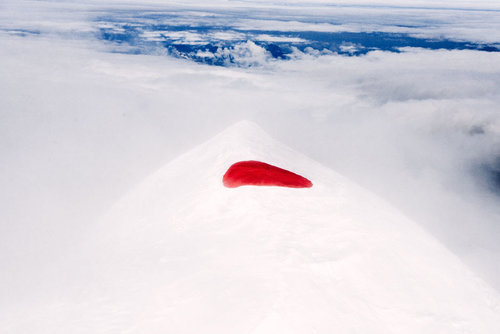

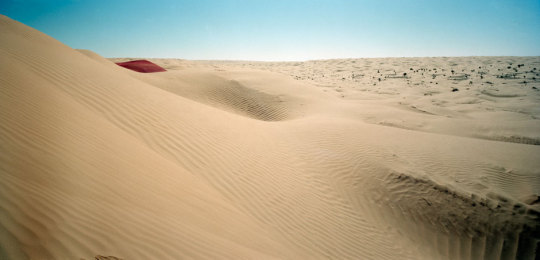
0 notes
Text
Installation Art - Claire Bishop
Installation art
First she distinguish the difference between the installation art and the installation of art. One is the layout and the presentation of a piece and the other the art piece itself designed for a special purpose.
To work the installation art works in correlation with the place of the viewer because the human being who constitute the subject of that experience (p8)
And it activate the viewing subject and decenter it in opposition to art as painting that requires only contemplation.
Ilya Kabakov talks about a total installation when there is a physical immersion and the viewer enters in a 3D space (and it is psychologically more absorptive too), the result of that is what he called the engulfment (when a scene is presented and the viewer project itself???)
For the installation art details such as the layout the path taken, the lighting are important because they will determine the perception of the art piece to the viewer.
Allan Kaprow
American Performance Artist and Theoretician
Movements and Styles: Happenings, Performance Art
Words
Exhibited at the Smolin Gallery in New York in 1962, takes the audience on a journey through two rooms, encouraging them to contribute to written and verbal components as they progress. Through this interactive environment, Kaprow denotes "urban text" referencing graffiti, billboards, newspapers, overheard conversations, and a lecture, engaging the viewer in a multi-sensory experience that literally brings "words" to life.
The importance of this piece is based in the responsibility of the viewer to become part of the creative process beyond passive involvement.
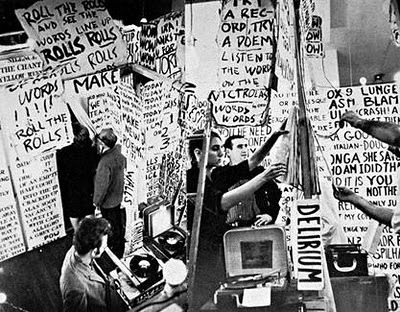
By reading that book I discovered Allan Kaprow and saw that what I want to achieve with the booth is similar to some aspect to his work: encouraging the audience to participate and go beyond passivity.
C’est quoi ta cause ? / What do you stand for ?
This is what I am asking in the video. If my aim with this work is to create a reaction and a take of position to the viewer, it made sense to me to take a position within the work and the video too, and one of the thing I stand for or would like to stand for in the future is the freedom of speech.
Or « Liberté d’expression » in French, and this is can be heard in repetition in the video.
I wish the viewer to write is response on the pieces of paper provided inside the installation and he will hang it on the strings.
If it works the result would be to have the installation full of statement from all the viewers.
0 notes
Quote
Probably that the artist is partial too
Mary Kelly (Installation art by C. Bishop p35)
0 notes
Text
The Yellow Vest Movement
Political movement that began with a petition posted online in May 2018. The first mass demonstrations began in France on 17 November 2018.
The movement starting first as a protest against the rise of the fuel price, then it expanded towards the high cost of living disproportionate burden of the government's tax reforms were falling on the working and middle classes, especially in rural and peri-urban areas and Emmanuel Macron's resignation as President of France.
The yellow jacket movement is not associated with a specific political party or trade union and has spread largely by social media and about 80% of the French population support the movement.
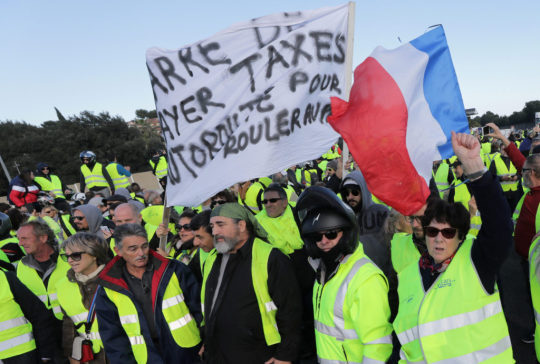
0 notes
Text
Bruce Conner
Pioneer of avant-garde filmmaking, Conner developed a quick-cut method of editing that defined his oeuvre. Incorporating footage from a variety of sources—countdown leaders, training films, and newsreels—and adding later his own 16mm film footage, Conner’s films also focus on disturbing but utterly current themes. For their structural innovation and daring subject matter, films like A MOVIE (1958) and CROSSROADS (1976) have become landmarks of American experimental cinema.
Report
Short avant-garde film of 13min consisting of found footage of the assassination of John F. Kennedy.
Completed over a three-year period, Bruce Conner’s Report is one of the key works of 1960s avant-garde cinema. Report is a film that asks for an affective response from its viewer but also requires forensic attention to detail and structure. It is never an easy film to watch. Roughly divided into uneven halves, it relies upon the principles of association, repetition, variation, recognition, and the often-contrapuntal relationship between sound and image to try to capture the “feeling” of the event.
A movie (1958)
vimeo
0 notes
Text
Vodka inspiration
The Kuleshov Effect
The Soviet film maker Lev Kuleshov demonstrated with his work that in a footage meaning is creating by the edit and the cut between two shots, and their juxtaposition.
For Kuleshov montage is the basic tool of cinema art.
That theory resonate with the work I tried to make, because my video consist in the edit and the juxtaposition of piece of footage I found from Youtube. I edited them trying to produce meaning and to pass my point of view to the viewer.
youtube
youtube
It is interesting to investigate on the origins and the fondations of montage in film, although those theories where created almost a century ago, and maybe to some extend they are not applicable today.
For example the fact that the meaning in a film is created by the edit between two shots made sense back then because all the shots were still and quite short. It is observable in Battleship Potemkin, and because the technical skills were limited at the time it was easier to produce meaning that way with the montage.
Battleship Potempkin
1925 Soviet silent film from Sergei Eisenstein. It presents a dramatized version of the mutiny that occurred in 1905 when the crew of the Russian battleship Potemkin rebelled against their officers.
The film is composed of five episodes:
“Men and Maggots"
"Drama on the Deck"
"A Dead Man Calls for Justice"
"The Odessa Steps”
“One against all”
The Odessa Steps: this sequence has been assessed as a “classic” and one of the most influential in the history of cinema and is one of the best example of Eisenstein’s theory on montage:
In A Dialectic Approach to Film Form Eisenstein said that montage is “the nerve of cinema”, and that “to determine the nature of montage is to solve the specific problem of cinema”.
"Montage is an idea that arises from the collision of independent shots”
“Each sequential element is perceived not next to the other, but on top of the other”
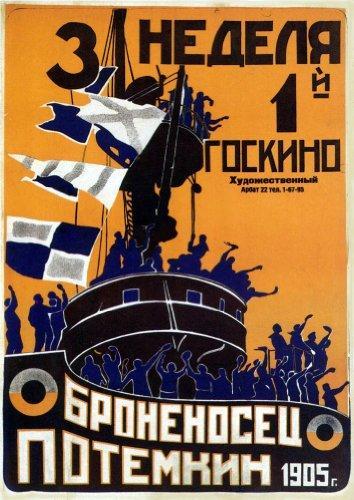
0 notes
Text
personal
I just realised that the terrorist attacks in France are a huge part in the video. It was probably both a conscious and unconscious process to select those footage because for the 13th of November and the attacks in Nice I was lucky enough to live in Australia.
When the attack in Paris the 13th of November was happening it was the morning of the 14th of November for me with the time difference.
I was living in an hostel at that time and was having my breakfast with another French girl before going to work. My phone was broken so I couldn’t use any form of social media. Then the girl was on twitter said that an explosion happened in Paris. We didn’t thought that much of it, then a couple of minutes later she said another explosion happened, then she said that could be an attack, then she talked about shooting, then the hostage situation, etc etc.
It was really strange to understand gradually about such a serious matter through twitter. Each minute new tweet from the other side of the world, that means both at the same time everything and anything.
It was the same thing with the attack in Nice. I was still in Australia but in a remoted part of the country working in a farm. I woke up and saw what was happening. As I am from Nice it was important for me to follow what was happening and again Youtube and social media were my only way to stay connected.
0 notes
Quote
be in the control of the video and don't let the footage control you
Peter Duke’s advice
0 notes
Text
Installation location
Choosing Expanded Media means the location of the installation is important and has its own meaning.
I don’t imagine this installation being in a class room or the university gallery, as one of the point I’m making (or will make) through my research is that political art should belong also somewhere outside museums and art gallery, and engage with wider spectre of people and not only artists (or people linked in the art field).
To validate that point I imagine it being in a space where everybody can access it, and not only the teachers and the others student in my class.
The Forum would be an ideal place, even if I am aware it requires a certain level of organisation.
4 days after:
After all I will not ask to put the installation in the Forum as I don’t feel or am not ready to put something that will be potentially seen by the all university.
Maybe it comes from a fear of being judge or because the video is violent and carries strong judgment on politic, art etc... I don’t feel like defend my views yet in front of everyone.
0 notes
Text
30th of November tutorial with Peter Dukes
New reference:
youtube
Martin Arnold is an experimental filmmaker known for his obsessive deconstruction of found footage.
Arnold's films are intensely cut sequences in which several seconds of old movie clips are taken and stretched out into much longer works. The motion is repeated and reversed, and numerous single frame cuts are made. His intent is to create, or possibly unearth, narratives concealed within the mundane films from which he samples. In films such as Pièce Touchée (1989) and Passage à l'acte (1993) for example he uses several seconds of the films The Human Jungle and To Kill a Mockingbird, the latter to create a bizarre story of aggression and tension within a traditional American family.
Book: Antagonism and relational aesthetics by Claire Bishop
0 notes
Text
Oh Bigot on TV
I chose to do a multi screen installation, and to only use footage from Youtube, because this website is one of the main way to watch content on internet.
My aim is to do an art piece using footage related to art, politic etc... which would be quite easy to get, and would be accessible for people who don’t have an artistic vibe.
My aim would be to raise this questions from the video: what is the responsibility of the artist? should we be more political?
In the end it reflects a bit on my view upon art, and I realise that will be a judgmental piece because I think there is a part inside the art world that it is either too elitist, and too close minded.
When hanging with artists or film makers, the only things they talk about is art or films. And I find it so boring. Art should be open on the world and what is happening outside its frontiers.
December: At first I wanted to select a wide range of video about politic, art, media, celebrities, war, from different countries or society and make a satire video out of it. My aim was to show a glimpse of the worst you can find on Youtube.
But it didn’t work because I couldn’t express my point of view through the edit. For example I was trying to critique a part of the art world and with the video it was like I was encouraging it.
So I tried to be more selective about the videos and I focused only on art and politic, and still it was quite boring to look at.
And with the tutorials I had my main advice was not to let the footage control me but to be in control of the video.
So in the end, I only selected videos that I find disturbing about politic, terrorist attack
January: Came back home during the Christmas period, and I saw my collection of Charlie Hebdo’s newspaper, and I realised that the week of the presentation of our work is going to be on the same week that the Charlie Head attack (7th of January 2015). This made me want to focus more about the work and focus on the freedom of speech.
0 notes
